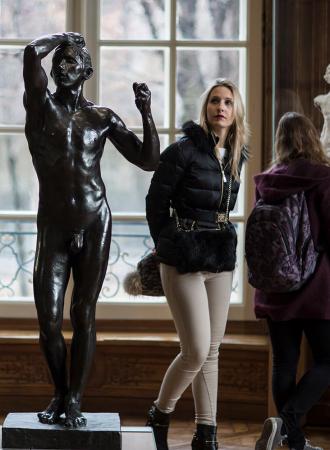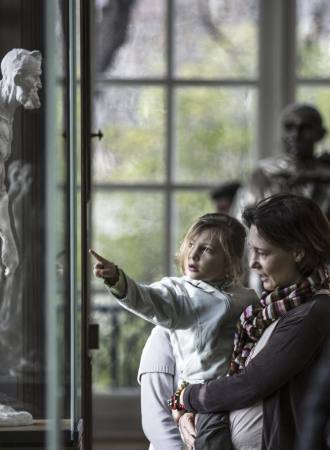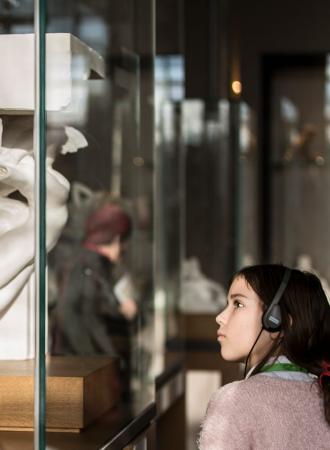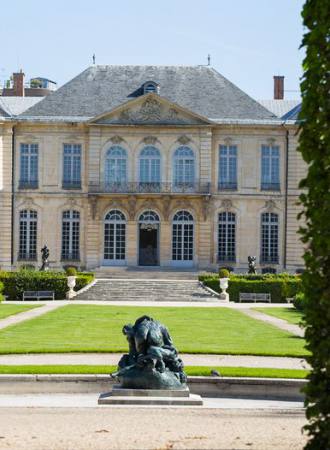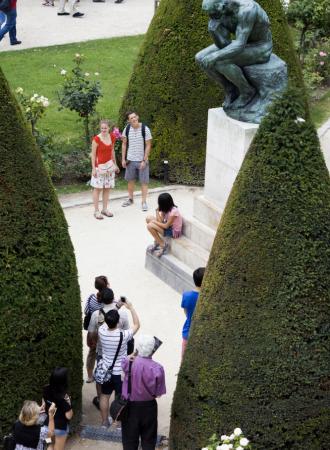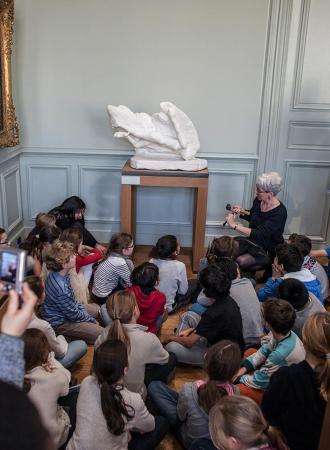Search the site
The hôtel Biron
First opened to the public on 4 August 1919, the Musée Rodin was housed in a mansion, formerly called the Hôtel Peyrenc de Moras. Now known as the Hôtel Biron, it was built in the Rue de Varenne, Paris, between 1727 and 1732. Nearly 300 works from Rodin’s collection are on view in this mansion designed along the lines of classical architecture and adorned with rocaille decoration.
THE HÔTEL BIRON IN THE 18TH CENTURY
The mansion that now houses the Musée Rodin was built in the Rue de Varenne, Paris, between 1727 and 1737, for the wealthy financier Abraham Peyrenc de Moras (1686-1732). The project, eventually overseen by Jean Aubert, Architect to the King, is a shining example of the rocaille architecture that was fashionable at this time. Constructed on the outer limits of Paris, it was both a town house and a country residence. Abraham Peyrenc de Moras died in 1732, before his new home, notably the interior decoration on the first floor, was completed.
In 1736, his widow rented out the mansion to the Duchess of Maine. While the new tenant did little to modify the exterior of the building, rather more alterations were made to the interior layout. When the duchess died in 1753, Peyrenc de Moras’s widow sold the estate to Louis-Antoine de Gontaut-Biron (1700-88), the future Marshal Biron. The changes he made mainly involved the grounds, which had been since then one of the most beautiful and best-known gardens in Paris. While respecting the typical layout of a French classical garden and the species planted by the original owner Abraham Peyrenc de Moras, Biron had added new features. He doubled the size of the ornamental garden, had a circular pool dug and made part of the grounds into an English-style garden. Peyrenc de Moras’s kitchen garden survived, but was moved to a different part of the estate. The appearance of the gardens during this period is well known, notably thanks to the descriptions and engravings of them published between 1776 and 1778. Marshal Biron leaved the mansion the name by which it is still known today, the Hôtel Biron.
THE HÔTEL BIRON IN THE 19TH CENTURY
From 1788, the Rue de Varenne estate was occupied by a series of owners and tenants. In 1795, for example, the Duke of Charost transformed the kitchen garden into an English garden, completed with stretch of water, and, for almost a year, rented out the entire grounds for festive events set in the countryside, where the public could play games, dance, listen to concerts and watch firework displays. In 1806-10, the mansion, leased to the Holy See, housed one of the papal legates, Cardinal Caprara, while, in 1810-11, the Emperor of Russia transferred his embassy there.
In 1820, the Duchess of Charost sold the entire property, complete with outbuildings, to three nuns, one of whom was the Reverend Mother Madeleine-Louise-Sophie Barat, founder of the Society of the Sacred Heart of Jesus. The religious congregation soon moved in and opened a boarding school for girls. During their occupancy, many changes were made to the buildings and the grounds, to suit the purpose they now served. As the years went by, the original decoration gradually disappeared; wood panelling, wrought-ironwork and painted decorations were sold to wealthy connoisseurs in order to fund the conversion work. In 1839, Marshal Biron’s pool was filled in order to erect a mound housing an ex-voto dedicated to the Virgin. By the late 19th century, the garden was primarily used as a kitchen garden, orchard and pastureland.
Between 1820 and 1904, several buildings to be used for teaching purposes and worship were constructed on the estate, the chapel in particular, designed by the architect Jean Juste Gustave Lisch, and completed in 1876.
The Society of the Sacred Heart of Jesus was dissolved in July 1904, the sisters were evicted and the property placed in the hands of the receiver.
THE HÔTEL BIRON IN THE EARLY 20TH CENTURY
The estate was put up for sale and while awaiting a buyer, tenants were allowed to occupy the Hôtel Biron from 1905. Among them were several artists, the writer Jean Cocteau (1889-1963), the painter Henri Matisse, the dancer Isadora Duncan and the sculptress Clara Westhoff (1878-1954), future wife of the poet Rainer Maria Rilke (1875-1921), who first told Auguste Rodin about the estate. In 1908, the sculptor thus rented four south-facing, ground-floor rooms opening onto the terrace, to use as his studios. The garden that had run wild probably made a strong impression on Rodin, encouraging him to place some of his works and part of his collection of antiques amidst its greenery. From 1911 onwards, he occupied the entire building.
Charles Berthelomier, L'Hôtel Biron, côté jardin, vers 1910 [Ph.1381]
The property was officially sold to the French government in 1911, a year after it had committed itself to purchasing the Hôtel Biron, to house the Department of Civil Buildings (then under the Ministry of Public Instruction), and the part of the estate bordering the Rue de Babylone, which was reserved for a new secondary school (present-day Lycée Victor Duruy). All the occupants except Rodin were asked to leave the building. Rodin does his utmost to save the mansion and starts negotiating with the state.
“I give the State all my works in plaster, marble, bronze and stone, and my drawings, as well as the collection of antiquities that I had such pleasure in assembling for the education and training of artists and workers. And I ask the State to keep all these collections in the Hôtel Biron, which will be the Musée Rodin, reserving the right to reside there all my life.”
Auguste Rodin - Correspondence of Rodin, volume III, 1908-1912, letter no. 103 to Paul Escudier, late 1909
In 1916, the National Assembly voted in a law that accepted the sculptor’s three donations and allocated the mansion and its garden to a museum, called the Musée Rodin, where the works donated to the French nation by Rodin would be exhibited. Léonce Bénédite was named executor of the sculptor’s will. The task of managing Rodin’s artistic heritage and supervising the organization of his future museum thus fell to him.
The museum was officially opened in 1919.
THE HÔTEL BIRON TODAY
Listed as a historical monument in 1926, the Hôtel Biron and its grounds have since undergone major renovation and restoration schemes, to better assert their role as a museum.
Vue de l'oeuvre
